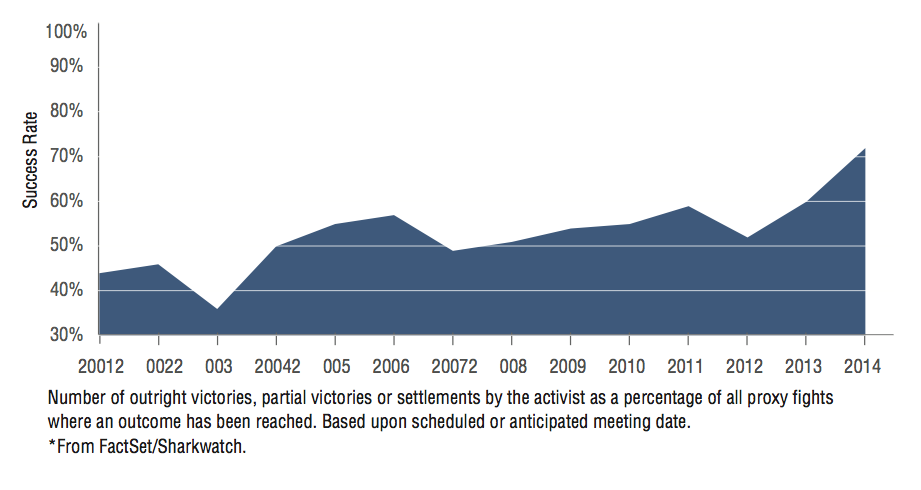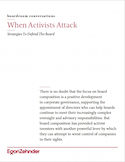When Activists Attack: Strategies To Defend The Board
There is no doubt that the focus on board composition is a positive development in corporate governance, supporting the appointment of directors who can help boards continue to meet their increasingly complex oversight and advisory responsibilities. But board composition has provided activist investors with another powerful lever by which they can attempt to wrest control of companies in their sights.
An activist’s claim that a current board has grown complacent through long tenure or lack of relevant industry experience has the potential to resonate with shareholders who already are primed to look at board composition more closely. But in the hands of an activist, arguments about board composition often are a pretext to create a dramatic display of conflict that can lead to the activist’s control. Even reasonable-sounding activist proposals calling for a single seat should be viewed as Trojan-horse footholds with multiple seats—and perhaps even full board takeover, à la Darden—as the ultimate goal.
Think like an activist from the outset
How should boards respond? In the same way that cybersecurity professionals continuously are probing their own computer systems to discover ways hackers might attack, boards need to be regularly examining their own composition to proactively identify and address chinks in their armor that activists could exploit. As with hackers, the goal is to get in front of the situation and deny activists an easy entry point from which to strike.
An experienced board consultant can play the role of the “white hat” hacker who helps companies defend against cyberattacks. We have deep experience in adopting the mindset of an activist to systematically identify every potential vulnerability that might be used against a director and then viewing the board through that lens. Because an activist only needs something that can be perceived as grounds for complaint, thoroughness at this stage particularly is important.
Where those vulnerabilities are real, the board must implement changes to its roster that will diffuse activist objections. Our extensive networks especially can be helpful in identifying potential directors beyond the usual suspects, turning what begins as a defensive move into a real opportunity to strengthen the board. Where those vulnerabilities merely are matters of perception, the next step is to develop arguments that will show why the current board is well-positioned to safeguard shareholder value.
The overriding goal is to prevent a director slate proxy fight before there is a crisis. An open battle, played out in the media, forces the nominating committee to make its moves on full display while fending off not just activists but news-hungry journalists and other commentators. It also is a serious distraction for the CEO and the senior leadership team, diverting energy and attention from running the business.
When the target is on your back
If the board has not been conducting such risk assessments on a regular basis and it suddenly is put on notice by an investor raising the issue of board composition, the above evaluation, conducted through the lens of the activist’s specific concerns, must be executed quickly. The clock is ticking; the key here is to move with urgency before matters escalate further. Additionally, the board will have no chance at prevailing with investors unless it handles the situation with confidence. Activists end up with full or partial victories in 72 percent of proxy fights; the days in which management got the benefit of the doubt are long gone. A board must demonstrate it has conducted its own composition “stress test,” made any changes needed, and be able to explain how the composition of the board is in alignment with shareholder interest. This will help to inspire the confidence that makes investors less likely to withhold support for the management slate.

When the battle is joined
If the situation has reached the stage of a director slate proxy fight, the issue has moved from the hypothetical to the concrete. If the assessment shows there are substantive weaknesses that call for changes, they must be made quickly. In these high-stress scenarios, we are able to provide the dedicated resources and expertise to turn the situation around in only a few weeks. The new and improved board then would have the ammunition it needs to define the terms of the debate and demonstrate that the resulting management slate is superior to the activist alternative.
Going forward
Co-opting the activist playbook through a specific assessment of potential vulnerabilities keeps the board in control of what otherwise can become a highly volatile situation. It does not, however, cause the activist to disappear. The day after winning the proxy vote, the board must redouble its efforts to address underlying issues that may hamper shareholder value. Egon Zehnder can bring valuable expertise and resources to address risks and highlight potential solutions regarding board composition so the board can continue to effectively do its job.






